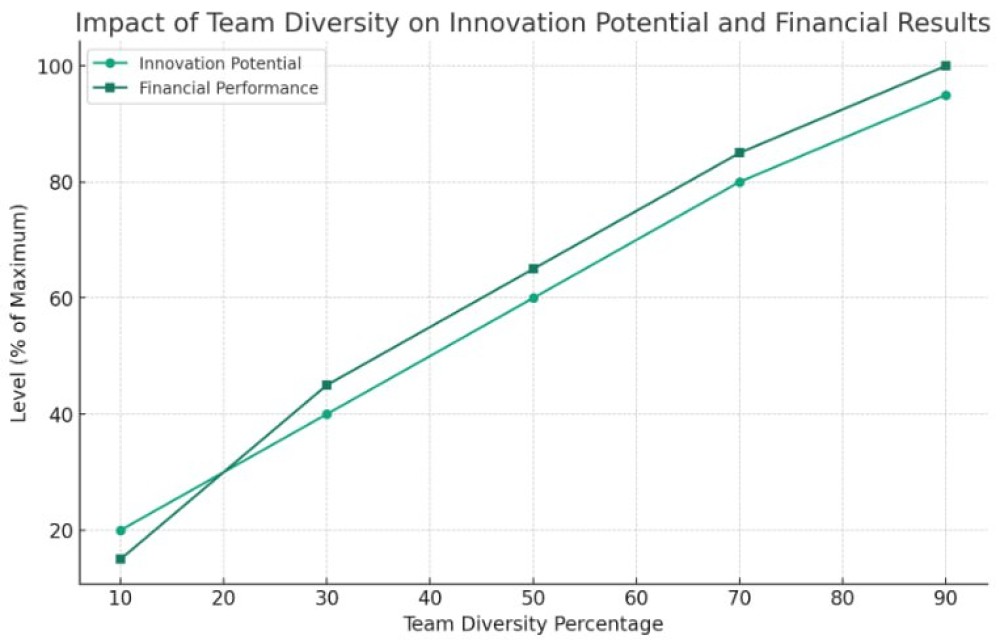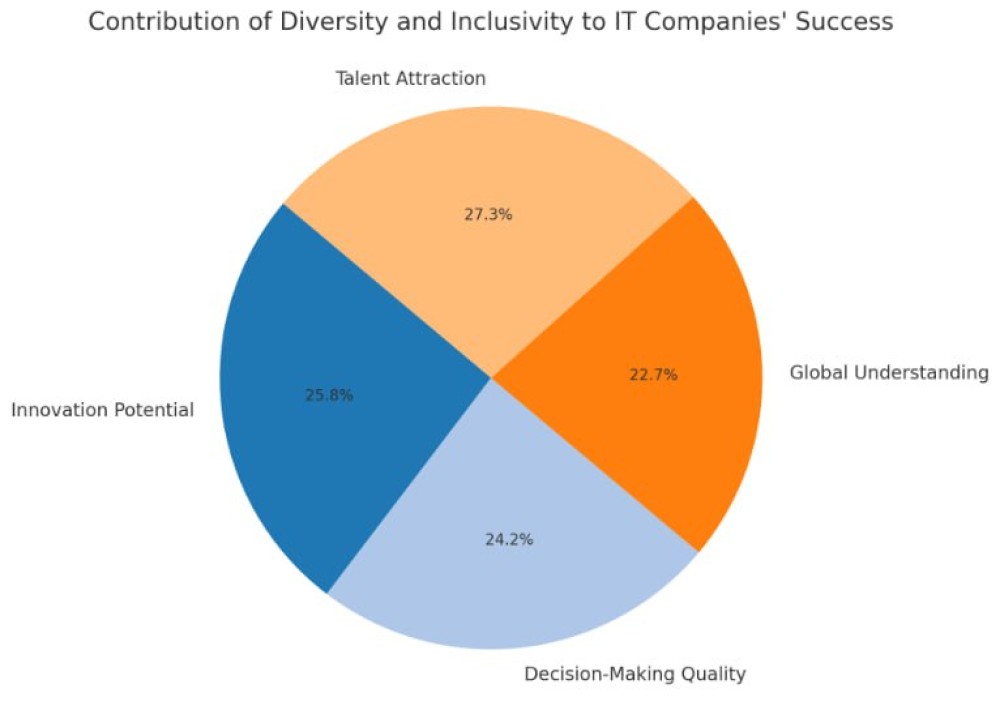Diversity and Inclusion in the IT Sphere:
From Need to Action
In the modern world, where technological innovation drives progress, the IT sphere is becoming an arena not only for technical achievements but also for social change. This is where diversity and inclusion come to the fore, promising not only fairness and equality of opportunity but also delivering increased creativity, innovation, and organizational performance.
The Meaning of Diversity and Inclusion
Diversity in teams is not just a moral imperative or a social requirement. This is a strategic advantage. Our company's research found that companies with high levels of diversity on their teams are 35% more likely to have above-average financial performance in their market. This is supported by other research indicating that diversity of ideas and approaches promotes innovation and creativity, key factors for success in a rapidly changing technological world.
Statistics and Visualization
For clarity, let's look at a graph developed based on data from our research, which compares the innovation potential and financial performance of companies with different levels of diversification in teams. The graph clearly shows a direct correlation between the level of diversity in a team and innovation potential, which in turn has a positive effect on the financial results of companies.

Conclusions from the Study
The study also found that companies with diverse teams not only better understand the needs of their diverse customers, but are also able to effectively solve complex problems thanks to a wide range of proposed solutions and approaches. This is especially true in the IT field, where innovation and quick problem-solving are the keys to success.
In conclusion, diversity and inclusion in IT is not just a trend or a social initiative. These are fundamental principles that help create a more innovative, creative, and ultimately successful industry. Companies, conscious Based on this principle, they will be able not only to stand out in the market but also to ensure sustainable development in the future. Building diverse and inclusive IT teams is key to building globally competitive and innovative products and services that meet the needs of a wide range of users and customers around the world.
To achieve these goals, companies must actively work to attract talent from diverse social and cultural groups, develop a culture of openness and acceptance, and create conditions for the growth and development of every employee. Engaging and supporting diversity in teams is not only a matter of social responsibility for business but also a strategic advantage that can significantly increase a company's innovation potential and competitiveness in the global market.
The Meaning of Diversity and Inclusion
In an era of globalization and technological innovation, diversity and inclusion are becoming key factors for success in the IT industry. Diverse teams cannot only generate a wider range of ideas but also come up with unique solutions to complex problems, which is especially important in the fast-paced world of information technology.
Contribution to Innovation
Diverse teams enrich the workplace with different perspectives, which directly impacts a company's innovation potential. Differing perspectives help prevent the “echo effect,” where the team tends to view problems and seek solutions within the framework of already known and familiar approaches. Including people with different backgrounds, cultural values, and professional skills on a team encourages new ideas and approaches that catalyze innovation.
Improving the Quality of Decision Making
Research shows that diverse teams make better decisions than homogeneous teams. This is due to the fact that during the discussion each participant makes a unique contribution, which allows us to look at the problem from different angles. This approach not only increases the likelihood of finding the most effective solution but also reduces the risk of missing important aspects of the problem.
Promoting Global Understanding
In the context of the globalization of the market for IT products and services, understanding the cultural characteristics of users and clients becomes critical. Multicultural teams better understand the needs and expectations of customers from different parts of the world, resulting in more tailored and relevant products.
Attracting and Retaining Talent
Companies that promote the values of diversity and inclusion attract talented people who want to work in an environment where their uniqueness and ideas are respected and valued. This not only improves the company’s image in the labor market but also contributes to the creation of loyal and motivated personnel interested in long-term cooperation.

The presented pie chart clearly shows indicators demonstrating the contribution of diversity and inclusion to the success of IT companies. Each segment of the chart represents a key area where team diversity has a significant impact:
- Innovation potential (25.8%) - Diverse teams contribute to the generation of a wide range of ideas, strengthening the company's innovation processes.
- Quality of Decision Making (24.2%) - Diverse perspectives and approaches in diverse teams improve the quality and validity of decisions made.
- Global Understanding (22.7%) - Having diverse teams on teams improves understanding of global markets and user needs.
- Attracting Talent (27.3%) - The company's openness and inclusiveness make it attractive to talented professionals from around the world.
This chart reinforces the importance of creating and maintaining diverse and inclusive teams in the IT industry by demonstrating how these factors impact key aspects of a company's success.
Incorporating and maintaining diversity and inclusion in IT teams is no easy task. This requires companies to make a conscious effort to create an open and supportive culture where every employee can feel valued and engaged. However, the benefits of this approach are undeniable. Diversity and inclusion drive innovation, improve decision-making, expand global understanding, and attract talent, ultimately leading to increased competitiveness and market success.
Overcoming challenges to diversification and inclusion
Incorporating the principles of diversity and inclusion into the corporate culture of IT companies poses a number of challenges. However, understanding and overcoming these barriers is essential to creating an efficient, innovative, and competitive work environment.
Unconscious biases
One of the main barriers to creating diverse teams is unconscious bias. These preconceptions and stereotypes can negatively impact hiring, promotion, and team interactions. To overcome these biases, companies can conduct special training aimed at identifying and eliminating them, as well as introducing objective criteria for assessing and selecting personnel.
Cultural differences
Diversity includes not only gender and ethnic differences, but also cultural ones. Understanding and respecting cultural differences is essential to creating an inclusive work environment. Companies can organize cultural events and training to help employees better understand and appreciate the diversity of cultures within the workforce.
Resistance to change
Any changes to an established corporate culture may be met with resistance from employees. To minimize resistance, it is important to ensure open communication about the goals and benefits of diversity and inclusion and to involve employees in the process of implementing change.
Integration and adaptation
Attracting employees from diverse social and cultural backgrounds is only the first step. It is also important to ensure their successful integration into the team and adaptation to the corporate culture. Creating mentoring and onboarding programs can help new employees fit into the team more effectively.
Overcoming challenges to diversity and inclusion requires focused efforts and commitment to diversity goals at all levels of management. This includes developing and implementing comprehensive programs to address bias, respect cultural diversity, train employees, and create a supportive environment. When done correctly, these efforts will lead to the creation of a more harmonious, creative, and productive work environment that promotes innovation and a company's competitiveness in the IT industry.

Practices in large IT companies: Diversity and inclusion in action
Large tech companies are often leaders in embracing and promoting diversity and inclusion practices, demonstrating the importance of these principles not only for social justice but also for business success. Let's look at the key practices and initiatives these companies are implementing to create more diverse and inclusive workplaces.
Diversity and Inclusion Programs
Many IT giants are developing comprehensive programs aimed at increasing diversity among employees and creating an inclusive corporate culture. These programs may include bias reduction training, representational recruitment initiatives, awareness-raising activities and support networking.
Mentorship and sponsorship
A key element in diversity strategies is the creation of mentoring and sponsorship programs. These programs help employees from minority and represented groups find mentors and sponsors who can support their professional development and career advancement.
Flexible working conditions
Promoting diversity also includes providing flexible working arrangements that accommodate the different needs of employees. This may include flexible hours, remote work options, and support for work-life balance.
Cooperation with educational institutions and NGOs
To expand the talent pool and support early career diversity, many IT companies are partnering with educational institutions and non-governmental organizations. These collaborations may include scholarships, internships and educational programs for students from represented groups.
Assessment and reporting
To track progress on diversity and inclusion, companies are implementing measurement and public reporting systems. This allows you to not only measure the current state of affairs but also identify areas for further improvement.
The practices of large IT companies in the field of diversity and inclusion demonstrate that these principles are an integral part of modern corporate culture. They contribute to the creation of an innovative environment, attract talent, and improve interaction with the global market.
Implementing these practices requires strategic thinking and commitment at all levels of management, but the benefits they bring are undeniable and tangible for both employees and the business as a whole.


